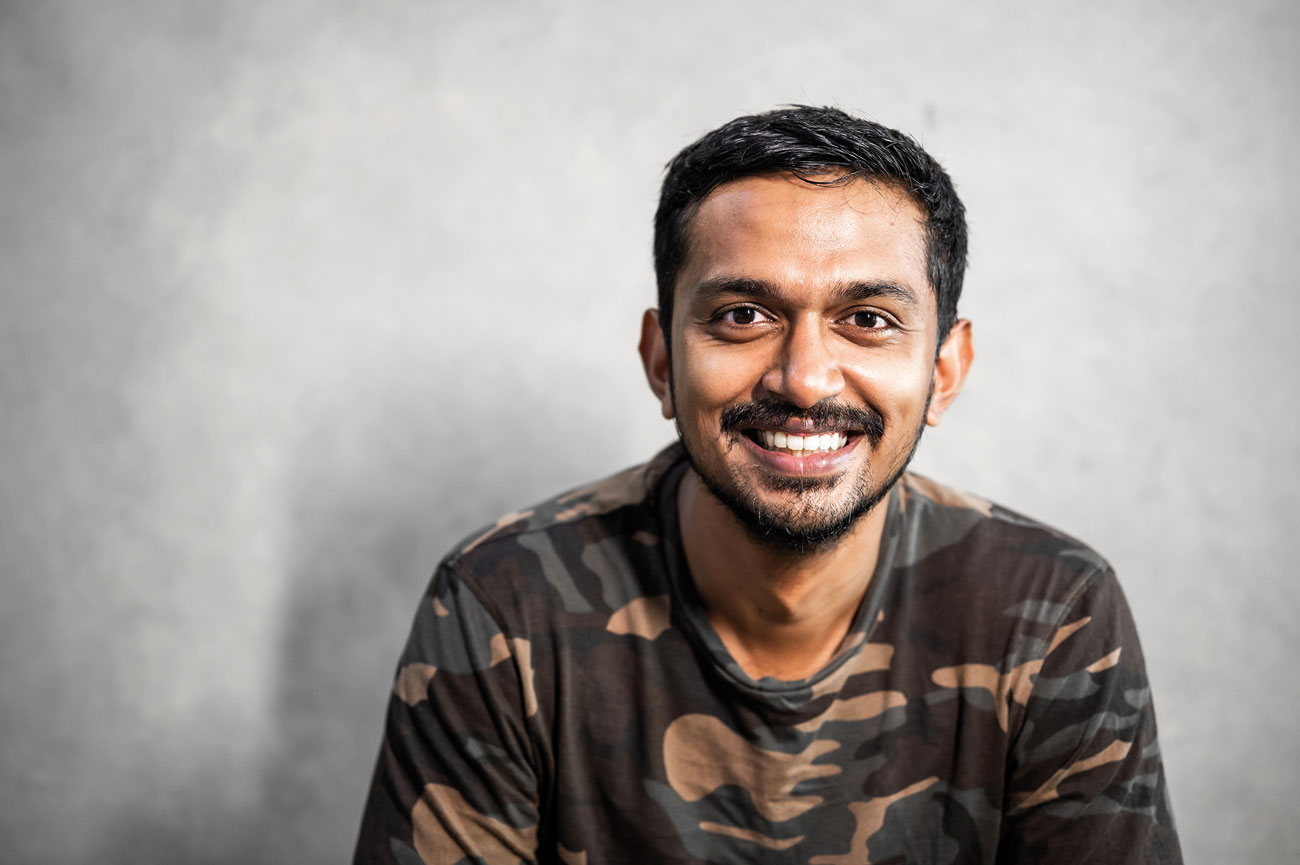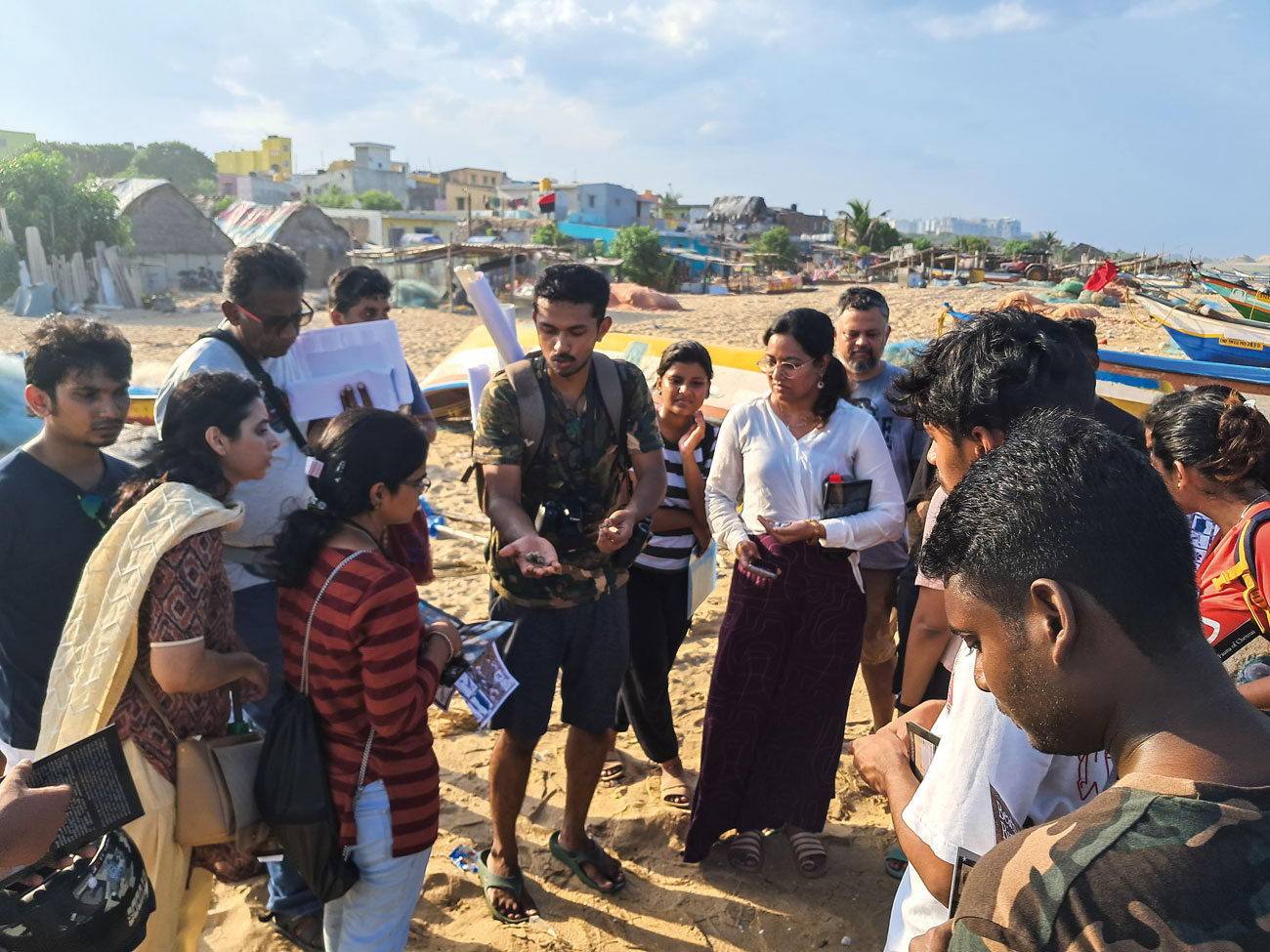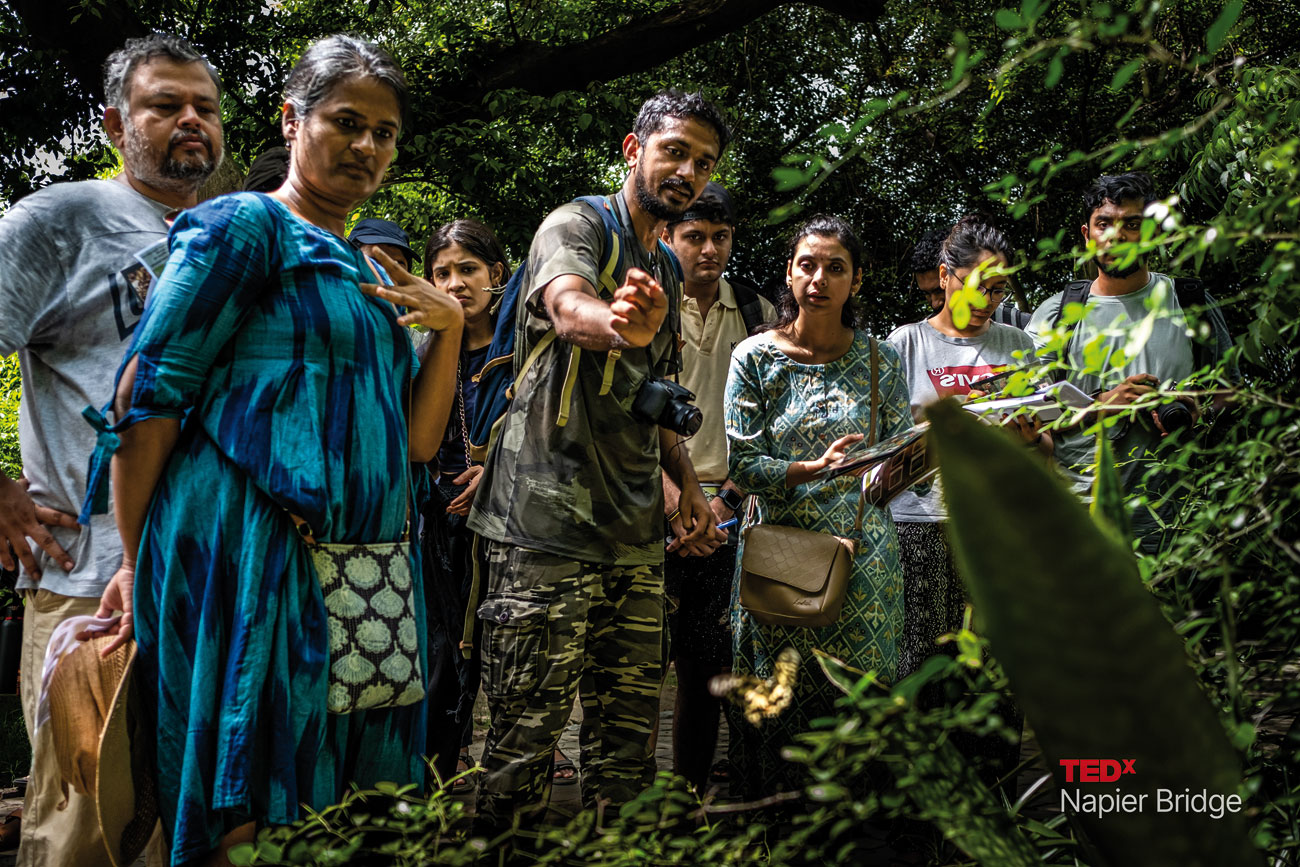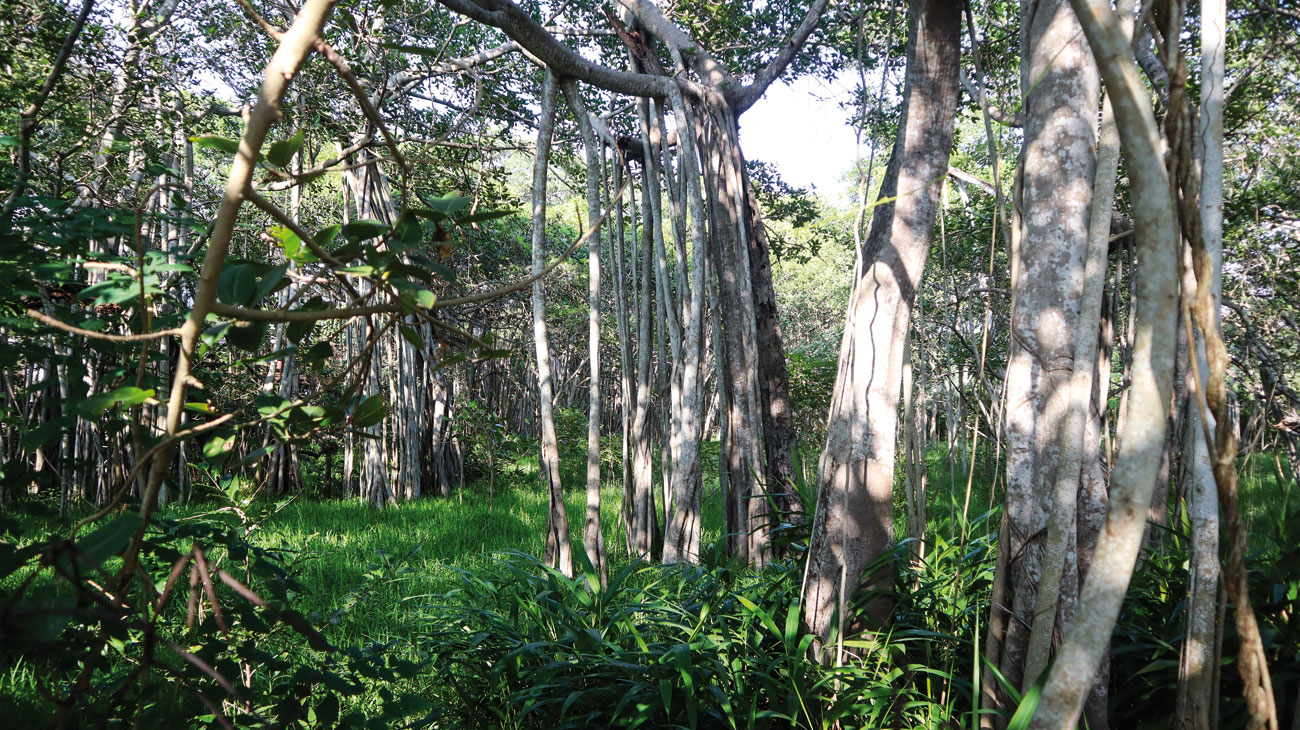Meet Yuvan Aves
First published in Sanctuary Asia,
Vol. 44
No. 4,
April 2024
Sanctuary Green Teacher of the Year 2021
The hand that rocks the cradle does rule the world, but when a child is out of the cradle and into the hands of teachers such as Yuvan Aves, Sanctuary’s Green Teacher of the year 2021, and author of the book Intertidal, a whole new world opens up, says Bittu Sahgal, who spoke with this remarkable young man with a vision for the future and a caring for the young and their planet.

Yuvan Aves believes the process of making peace and reimagining our relationship with the biosphere will need to draw heavily on the wisdom and experiences of the hope-holders of yore, as well as imaginations into lifepaths not yet existent. Photo Courtesy: Pradeep Sekar.
Tell me about the Theosophical Society’s famous banyan tree that influenced who you are today.
The question delves into childhood and what childhood means. A lot of what I’ve been investigating through education is building connections with the local living world during childhood and adolescence, one of the most formative periods of our lives, with connections that span a lifetime. ‘The Banyan Tree’ became a universe for me. It was large, living and giving. It taught me that barrenness is always a state of mind, never a state of land. It enabled me to deepen my understanding of the world in a physical and spiritual sense. I had very profound experiences and relationships with the banyan and many other parts of our massive green campus. Given half a chance, this is possible for children to have in whatever form that nature is available to them.
These questions reached you on March 8, Women’s Day. What is your take on patriarchy?
I read about Richard V. Reeves’ Boys and Men Project and began looking at structures of inequality, patriarchy perhaps being the most prominent and dominant of those, and how that has robbed us of childhood. And I think a defining part of childhood is connection with nature. For instance, much of schooling is about learning to be a docile desk worker. Do not question. Do not investigate by yourself. All such and more. Jason Hickel put it wonderfully, suggesting in effect that we need to view the labour movement, the women’s movement and the ecological movement together because they were triggered by the same powers.
Counterintuitively, one of the unrecognised victims of patriarchy is men. Consider child sexual abuse scores, where boys are more abused than girls. We talk about STEM fields (science, technology, engineering, and mathematics), where more women need to be. You look at HEAL fields (health, education, administration, and literacy), which are far more job prone, and form the backbone of society. Men’s rates of employability are radically dropping in HEAL, while women are far more employable. And the capacity and opportunity to widen as a human being is straightjacketed for boys by the stereotype into which they are locked very early. This is particularly true of the teaching profession!
_C-1300_1712139481.jpg)
Biodiversity can be a political science teacher and equaliser of human spaces. Here during a butterfly walk in Thirumalayampalayam, Coimbatore, children of various communities – usually segregated in their school – came together, walked and worked together, their differences dissolved by the wilderness. Photo Courtesy: Palluyir Trust.
How right you are. Yet, here you are, a teacher par excellence!
True, but I remember walking in my apartment complex with my mom when an elderly gentleman friend asked what I did. I replied I had written a book recently, many children’s books in the past, run an organisation, and take up legal cases to save wetlands by approaching the National Green Tribunal, and other such work. He was, like, “Yes, good, good. You’re still young. You can still write the UPSC exam and make something out of your life!” Life seems to have been chosen for boys long before they become men. Take therapists. I’ve tried to find a male counsellor without much success in India. As I said, under patriarchy, boys and men are victims too, unless they were ‘rescued’ by sensitive, thinking parents and guardians. Power systems breed inequality, be it patriarchy, or versions of patriarchy. In my view, virtually any system of inequality impacts the less empowered, irrespective of gender. I hasten to add, without underplaying the fact that women/non-binary people are primary victims, that the victimisation of men is present, but largely invisible.
Your school, Pathashalla – is it still a part of who you are today?
It is. In my ‘beinghood’ it’s still very much a part of me. Though I’m not associated with the school any longer, this rural residential campus about 70 km. from Chennai, is a refuge amidst Reserved Forests, hills and paddy fields, near the Palar river basin and a host of wetlands. When I ran away from home at the age of 16, it became my life-saving refuge.
And you have now made it your mission to prevent children from being distanced from nature?
That’s one key mission. Right now we are working with the Greater Chennai Corporation to make local nature-based learning a policy in all schools in the city, and we’ve made some headway. The larger dream is to enable ways for children to grow up profoundly being and feeling connected to the local living world. I think the most crucial thing nature-engagement gives them is an expansive-selfhood – spread across lakes, butterflies, snakes, flowers and mushrooms. Then when they grow up they will stand up for themselves, which is the living world. Children need direct engagement with nature, not merely intellectual. Whether I get two hours with a child, or two years… in that time I seek to help them make profound connections with their living scapes. I want our children to experience interconnectedness, especially the social, political and ecological interconnectedness they will need to understand as they grow up and take charge of the world.

A shorewalk for the public at the Urur Kuppam beach – where much of the book Intertidal is set. Through direct experience and connection with the local living world, children and adults come to care for it, stand up for it when under threat. Photo Courtesy: Palluyir Trust.
And yet, as awareness of our climate and biodiversity problems grows, we seem to be locking ourselves into more self-constructed silos.
Bittu, that’s a given. Mere awareness is an illusion. One that seldom results in action. We all need connections. Connection with a wetland, connection with a banyan tree, connection with a flock of migratory birds. Also direct engagement with other humans beyond presentations of ideological, intellectual proof. If such one-dimensional interactions worked, we would all be climate warriors given the sheer volume of climate disaster news that dominates mainstream media today. Humans, young and old, need personal, emotional meaning and context for anything to become a part of their identity and life paths.
You are a classic example, I guess, of being a student and teacher! How did the likes of M. Krishnan, Robert MacFarlane and Annie Dillard shape your life?
My response may sound inconsistent with my earlier answer. From Grade Seven onwards I would tell adults that I want to be a naturalist. For me, that meant a way of life, a set of values and experiences that allowed me to interact with what was alive in my seeing of the world. Not a vocation. Yet, adults would say: “I suppose you will then be OK with begging for money? That disillusioned me and, I expect, many young children who long for a life enriched by wildernesses. The regimented control adults exercise, defeats most children. Fortunately, I was given opportunities to viscerally experience nature as I grew. As an 11th Grader, I found myself in a residential campus, as the only one self-educating at the age of 16… while also running biodiversity learning programmes for three rural government schools! I was in search of a career that did not exist.
Like Antonio Machado powerfully articulated in his iconic poem Traveler, There Is No Path:
Traveler, your footprints
Are the path and nothing more;
Traveler, there is no path,
The path is made by walking.
I had no accessible mentors, who might have helped me find a career that incorporated my passion. So the three writers you mention above, among many writers, became role models who helped me become who I am. I would read their writings, and those of others, again and again, while managing to imbibe inspiration from the landscapes through which I would walk. They all chose to veer onto untrodden paths to shape their lives in deep conversation with their living worlds. More than obscurity, they chose a sort of invisibility. Mentorship was nevertheless vital, and Robert MacFarlane became that for me. He is one of my closest friends now, with whom I have co-written an album of songs called Night Creatures. We spent time together in Chennai and his book Is A River Alive? (coming out in 2025) speaks of the rights, life and death of rivers.
So you are a student and a teacher. How does that work?
That’s a very Zen question, well answered by Edgar Dale, who came up with The Learning Pyramid. The top of the pyramid, when you don’t learn much, is when you’re sitting and passively listening. Your presence is passive. At the bottom of the pyramid, massive learning takes place when you are creating a learning experience.
At different points in my time, I’ve been a conventional direct student, but more than ever, I’m a student now because as a nature educator the learning is continuous. You are constantly creating material, inventing, and brainstorming to find new avenues of learning. When you take children outdoors you are essentially facilitating. You cannot set a curriculum for nature activities, where spontaneity is the order of the day. It’s quite the opposite of shoving them into a classroom, glueing them to their desks and repeating the exercise each year, sometimes for decades. Once you take them outside, suddenly the heron becomes their teacher, as does a caterpillar, or a sunbeam butterfly. It’s a sort of dynamic, fluid way of teaching and facilitating learning. When I was a dormitory-parent, I was once rearing a Carea angulata caterpillar that I referred to as ‘the big headed moth’. Its host plant is the jamun tree and my students would help gather some fodder every few days, make observations, notes and stuff. Talk of imagination? When the moth finally emerged from its cocoon one boy remarked that its huge head made it look like Mojo Jojo from The Powerpuff Girls! The moth stayed still for almost an hour and he asked me: “During the caterpillar stage it never flew, so when it comes out how does it know to fly?” And I’m like, “What the hell? That’s a cool question!” But when I went back to search for an answer, I discovered that science had no answer because when the tissues of a caterpillar are de-differentiated, all its memories are erased. Yet, as a moth, it retains memories of where it was born, where it has to lay eggs, and what it can do physically.

Public spaces and commons are places where often nature thrives and also is at its most vulnerable. Regular engagement with people, letting them experience the ecology of the commons, seeing its essentiality for all forms of their wellbeing, is needed in cities. Photo Courtesy: TEDx Napier Bridge.
Let’s move to your book, Intertidal! Tell us about the space and the book.
Difficult question! I was at the Bangalore Green Literature Festival last year and was asked to speak about the book. For 10 seconds I thought to myself, “Wait a minute, what is this book about?”
I’ll try, but I guess you would need to read it yourself. It’s a diary of deep coastal observations, of wetlands, of oneself, of the spectrum code between ‘selfhood’, ‘coasthood’ and ‘beinghood’. It’s also an account of standing up and taking ground actions and teaching. And learning. It spans many things. First, through direct deep observations of the local living world, where you stumble upon truths about the human psyche and your own psyche, and then to heal, or grow in ways most needed.
In the book I explore the intertidal between self and the other, between nature and culture. This is a common thread between seeing, constant navigation of entanglement and non-separation. It’s abstract, as you can imagine, but started with the very real Pulicat lake campaign where we are trying to stop a 6,111 acre port from being built, on Chennai’s most important coastal river, Chennai’s most vital wetlands and the Pulicat lagoon, all threatened by the port.
So how can Chennai learn to live with its rivers? Adyar, Paalar, Kotralayar and Cooum, and its once-fabled wetlands?
By remembering that cities grow around rivers. Young people must not forget the trauma of the relatively moderate Cyclone Michaung, which hit Chennai (sitting just six metres above sea level) on December 4, 2023. An estimated 20 people died and thousands were marooned when around 53 cm. of rainfall inundated the city in 48 hours, submerging residential buildings, and washing away cars and cattle in powerful currents. Cars were washed by the resulting floods into river basins, possibly some into the sea. Crocodiles were swept into the city. The three-day flood saw our food running out. Our Palluyir Trust’s ground floor office was submerged under a metre of water. We lost everything, and it was only thanks to supportive donors that we managed to recover most costs. The media kept harping on climate change, but climate change does not act in isolation. It brings existing fault lines to the boil. That includes poor land and water management. Few Indian languages have more words for waterbodies than Tamil… eri kulam, kuttai, kundam, poigai sengai, all waterbodies with specific ecologies and functions, cultural and geographic. Our ancient water management customs were the centre of our lifestyles. The same was true for Bengaluru and a host of other Indian cities, whose waterbodies have been swallowed by ill-advised real estate projects. We suffer ecological amnesia, forgetting our water crises no sooner they have passed. Soon we will suffer the predictable consequences of drought. We must ask why we nurture such a toxic relationship with water, which is our most important life-giving resource. We need to restore our sacred attitudes to water and water sources, a fact that you yourself picked out Bittu, from Intertidal: “Climate change may be measured in carbon, but its mother tongue is water.”
So how will Chennai learn to live with its rivers and wetlands?
By growing collective attitudes and strategies to start the slow climb back to ecological foresight. Wetlands will have to be restored. Wastelands were never wastelands and barrenness is really just a state of mind, not a state of land. The catchment areas of lakes and rivers have always harboured forests and grasslands to sponge the rain and feed aquifers capable of storing more water than all our artificial surface water reservoirs put together. We cannot pave those catchments and then complain about a water crisis caused by the inability of lands to absorb rain to soak and percolate. Water has a subterranean subconscious life, deeper than its surface presence. The yearly facade of wetland restoration, and engineering rejuvenation is farcical. The first people to suffer such contractor-driven, GDP-pushing discriminatory upstream development solutions are the poor, who live downstream with tin or thatched roofs, and fisherfolk. who live in the floodplains of rivers they have no hand in destroying. Climate change, as Lord Nicholas Stern of the London School of Economics’ India Observatory correctly said, is clear evidence of market failure. Everything returns to power structures, patriarchy and our dysfunctional political system. Clearly, patriarchy is bad for hydrology.

The Great Banyan of the Theosophical Society, thought to be easily over 500 years old. Its phyllosphere as large as a monsoon cloud, it developed a connection with various revolutionary educators/thinkers including J. Krishnamurti and Maria Montessori. Photo Courtesy: Yuvan Aves.
Do you see Homo sapiens making peace with the planet within your lifetime?
Our hope lies with our children, who will grow up with a greater understanding of and respect for the biosphere. We take children to heronries like Vedanthangal with 70,000 birds nesting right in front of them, completely trusting of human presence. Consider many bird sanctuaries in Tamil Nadu, such as, Karaivetti, Osudu, Karikili. All of these are human-made hydrological structures designed by our forefathers from within a culture of deep respect and understanding of the ecologies. I guess we will see Homo sapiens making peace with the planet, only when we see birds, trees and wetlands as kin.
The process of making peace and reimagining our relationship with the biosphere will need to draw heavily on the wisdom and experiences of the hope-holders of yore, as well as imaginations into lifepaths not yet existent. But empty hope means little. All hope needs to metamorphose into action on the ground. Some write off the defence of our homes as activism. Be that as it may, the writer Alice Walker got it right when she wrote: “Activism is the rent I pay for living on the planet.” And irrespective of how they interpret my actions, I am not fighting for a river… I am the river.
Talking about rivers, can anything be done about the Tamil Nadu-Karnataka slugfest over the Kaveri waters?
My God! Okay. One thing, and my response will be limited. All too often very large power systems apply uniform solutions to large landscapes that are contiguously diverse. Dams are built on lands with thousands of years of histories, where civilisations thrived since the Stone Age. In between, many civilisations perished because its occupants tampered with river basins. But records exist of small-scale populations with deep riverscape connections that coexisted without harming rivers, which were often worshipped as sources of life.
Those were practical, long term, specificity-based solutions that we will need to revisit. So that would be the perspective I would bring. We will need to relearn how to treat rivers as being beyond human politics. Author Amitav Ghosh calls rivers “Earth entities”. Complex Earth entities. The Mishmi, Lepcha, and several northeastern cultures believe rivers are living beings.
How do we bring that into a political narrative? How can we return to respecting the ecological integrity of our rivers? How do we treat rivers such that the aquatic migrations of fish and silt can continue as they once did? This may seem impossible, but it’s inevitable. That’s where the Kaveri river solutions lie. If humans cannot find political solutions, the biosphere will apply its own time-tested ways to bring Homo sapiens to heel.
Meditation. Urur Kuppam. Palayam anna. Nityanand Jayaraman. What do these words/names bring to mind?
Meditation in spiritual traditions and the traditions of neuroscience, involves direct observation and experiences of reality in the space beyond thought. All religions were birthed by the most primal form of meditation, all connected with the living world.
Humans learned how to navigate the seas by understanding currents and possibly following sea turtles that swim passively by catching longshore or ocean currents. Sea turtles act as guides, and mentors do the same. Palayam anna is a fisher elder, who taught me how to read winds and see currents and helped me to vividly comprehend what a coast is.
Nity? To my mind he is one of the finest, most sensitive and intelligent environmental activists in India. He speaks his truths, without fear of favour. He also taught me to read documents, craft campaigns, communicate messages and work respectfully with communities.
Nity and Palayam anna, have been collecting data from the Urur Kuppam village for five years, looking at storms, changing weather patterns horizontally, the way the meteorological department does, but from within. Drawing insights from those who understand the sea, they have documented local climate and land use change in stunningly illuminative ways.
_C-1300_1712140022.jpg)
Yuvan Aves with children at the Vedanthangal Bird Sanctuary, which is a nursery for tens of thousands of waterbirds and also a nursery for numerous children, birthing their love for birds and hydrology. Photo Courtesy: Palluyir Trust.
In Conclusion?
The climate crisis is real, but it’s a mathematical model that is cold-bloodedly being used as a scapegoat by the powers that be, who bandy the threat about and offer one-size fits all solutions. For local communities, climate is an abstract phenomenon. Ditto for children. Ditto for those in urban or rural areas who struggle to make ends meet tomorrow. Water on the other hand is a tangible, embraceable phenomenon that could trigger mass participation to force political decisions on those with extremely short term objectives, who control the current political, economic and social agendas of virtually all the nations of the world.
We need to focus on the misuse and gross mismanagement of our natural land and water assets. As COP 28 demonstrated, the fossil fuel sector loves talk shows that are monopolised by technical solutions, which they control. A few months ago, the Earth Commission, for the first time ever, quantified all our Earth system boundaries. Climate is certainly one of them, but the biosphere’s functional integrity is without doubt the real one, and if we focus on that and fix it, the climate crisis will have been greatly solved, far more effectively than the current strategies which insidiously place solutions at the doorstep of consumers and farmers and the like, while using delay as a weapon to enrich their coffers and political power.
Meanwhile sea levels keep rising, coastal aquifers are fast getting salinised, and natural resources – the safety net of the poor – diminish by the day, even as illogical plans to push GDP keep getting proposed and implemented by way of projects that end up aggravating rather than tempering the impact of the climate crisis.



_C-1300_1712139481.jpg)



_C-1300_1712140022.jpg)